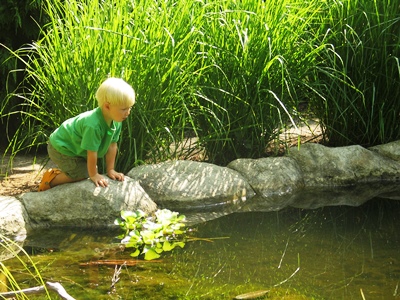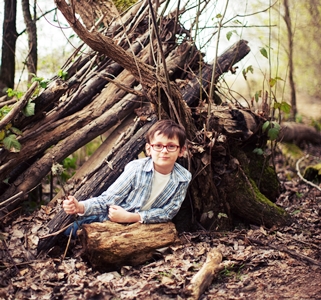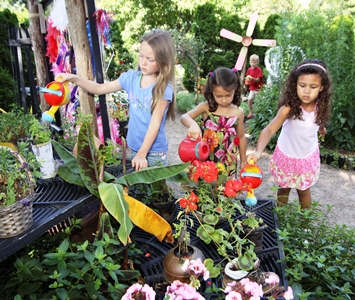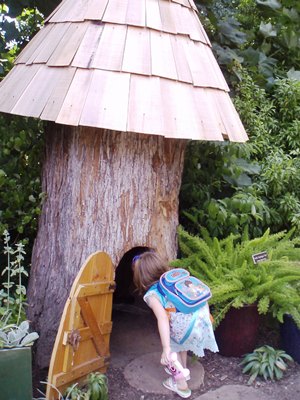As children, my sister and I would spend happy hours hiding out in our “cave” in the heart of a massive forsythia bush and conduct death-defying crossings on rickety logs over streams full of “ravenous crocodiles.” When my third grade teacher instructed the class to describe our pets, I turned in a page filled with drawings of squirrels, rabbits, birds, and other critters that were as much a part of my daily life as my dog.
When asked about childhood memories of time spent outdoors, most of us wax nostalgic about splashing wildly in streams, climbing to dizzying heights in trees, and defending shaky stick forts from the onslaught of villains — not about climbing monkey bars and plastic slides.
Sadly, the once-common practice of mothers waving children out the door into the sunlight, telling them simply to “come back when the streetlights come on,” is virtually unheard of these days. It is an anomaly to see a child perched in the branches of a tall tree or playing anywhere outdoors other than on a ball field or designated playground equipment. In fact, many kids have been led away from outdoor experiences completely by the lure of online entertainment.
A Changing Landscape
In “The Landscapes of Childhood,” published in the journal Environment and Behavior, psychologist Rachel Sebba poetically suggests that the natural landscapes of childhood become the inner landscapes of adulthood. As the world undergoes the largest wave of urban growth in history, the landscapes of neighborhoods are changing drastically, dominated by cement, mowed lawns, and manufactured playground equipment. Any natural areas are often governed by covenants and homeowner agreements limiting activities like fort building and unstructured play. The creativity and imagination sparked and nurtured through free play and exploration has been replaced by “packaged imagination” handed to kids in the form of mass-produced plastic play sets and entertainment flickering through computer and television screens.
Today’s children engage in exponentially more screen time than green time. According to a 2010 Kaiser Family Foundation report, children and teens spend more than seven hours a day in front of “entertainment media” — television, computers, video games, cell phones, and iPads. That’s more than 50 hours each week that youth are “plugged in” — an increase of more than one hour per day since a similar survey in 2004. Author Richard Louv spoke of the impact of all this screen time in his groundbreaking book, Last Child in the Woods: “Society is telling kids unconsciously that nature’s in the past, it really doesn’t count anymore, that the future is in electronics and, besides, the bogeyman is in the woods.”
Yet the true value of learning about one’s world through hands-on discovery cannot be duplicated by sitting indoors in front of a screen or by engaging in unimaginative, repetitive play on manufactured equipment. A 2011 article in The Atlantic entitled “The Creativity Crisis” notes that organizations such as NASA and Boeing already sense a growing deficiency in creativity among the incoming workforce. Recent graduates are incapable of thinking in three dimensions, and companies now consider ideal candidates those who can “think with their hands” instead of simply creating things on a screen. Stanford University recently refocused on hands-on learning partly due to the frustration of engineering, architecture, and design professors who realized their best students had never taken apart a bicycle or built a model airplane. There is simply no substitute for hands-on exploration, and the multifaceted setting of nature is the perfect vehicle to encourage the development of critical creative skills and reconnect youth to the “real world.
Rethinking the Conventional Playground
Nature playspaces are indeed playgrounds — but not in any conventional sense of the word. Perhaps the best way to explain what they are is to explain what they are not. Instead of a play area dominated by brightly colored plastic and metal structures, nature playspaces are constructed almost entirely of natural materials: stumps to jump on, logs to crawl through, shrubs to hide in, habitats to explore. They can be as simple or expansive as you can imagine and can be created anywhere, at any size, on any budget.
In the mid-1800s, at a time when the Industrial Revolution was spurring mass migrations into cities and isolating children from the natural setting of rural life, innovator Friedrich Froebel pioneered the first kindergarten, using plants, animals, and loose building materials to entertain and educate young children. Unfortunately, much of the natural free play aspects of urban play areas were gradually abandoned in favor of commercial play equipment designed purely for physical fitness. Despite the fact that monkey bars are a ubiquitous part of America’s landscape, childhood obesity rates have tripled in just one generation. “One note” environments like ball fields and conventional playgrounds provide a valuable opportunity for kids to get outside but fail to encourage the diverse types of play that enhance social and intellectual skills and provide emotional and physical benefits.
Benefits of Nature Play
Research increasingly shows that diverse green space lowers children’s stress levels and positively affects behavior. Several studies found that children with views of and contact with nature score higher on tests of concentration and self-discipline and that children with symptoms of attention deficit hyperactivity disorder (ADHD) are often better able to concentrate after contact with nature.
Natural environments also encourage social interaction among children, featuring imaginative and creative play that fosters language and collaborative skills. Instead of the predominantly solitary activities conducted on conventional playground equipment, nature playspaces encourage children to interact with one another and use language creatively to engage other children and describe imaginative scenarios.
Research studies have also shown that an affinity for nature and a positive environmental ethic emerge from regular interaction with the natural world during early childhood. Conversely, children’s loss of regular contact with the natural world can result in a generation disconnected from and disinterested in conserving the environment.
Designing for Adventure
 Fortunately, reconnecting children with nature can be as simple as a stick fort or a ring of giant sunflowers. Imagination is the critical ingredient of nature playspaces — not expensive building materials and prescribed ways to play. In Childhood and Nature, renowned educator and author David Sobel describes key design principles for creating imaginative playspaces.
Fortunately, reconnecting children with nature can be as simple as a stick fort or a ring of giant sunflowers. Imagination is the critical ingredient of nature playspaces — not expensive building materials and prescribed ways to play. In Childhood and Nature, renowned educator and author David Sobel describes key design principles for creating imaginative playspaces.
Adventure, Fantasy, and Imagination
Provide opportunities for children to engage in physical play — climbing through hollow logs, clambering over boulders, hopping across “stump jumps.” Children learn best by performing a physical activity rather than just listening or watching. Exercise the imagination as well with features like mud pie kitchens, dinosaur digs, and “secret” paths to hidden nooks. Imagination thrives in young children, and we need to create opportunities for kids to experience challenges firsthand. As Sobel says, “Walks are for adults; ‘adventures’ are for children. Adventures imply that you don’t know what’s going to happen. There is valuable learning in dealing with the unexpected.”
Animal Allies
Children are fascinated with animals, but too often a child’s interaction with wildlife is limited to an occasional zoo visit or a bird glimpsed through a window. Inviting wildlife into your playspace is inexpensive and simple. Plant a native butterfly habitat — a sunny patch of milkweed will mesmerize children as they witness the lifecycle of visiting monarch butterflies. Simply planting fennel and parsley, even in a container, will likely result in the “sudden” appearance of gorgeous swallowtail caterpillars munching away.
It’s easy to attract other types of wildlife as well. Construct a simple wooden wall with viewing slats as a wildlife observation area, then plant berry bushes, sunflowers, and thistleseed bearing coneflowers to naturally attract birds. Ponds big and small offer an inviting space for critters — even a container pond. Worm composting bins introduce an important recycling concept and help eliminate the “ick factor” about less glamorous critters.
Maps and Paths
Include a variety of pathways for visitors of all ability levels to explore. Laying a concrete path? Imprint it with animal tracks, leaves, and shells. Mow a path through a meadow and make paths through vegetable gardens for easy access. Put log slices down with nature messages woodburned in. Create path borders with natural items like logs or flower bulbs and create archways or tunnels out of willow. Purchase a large drainage pipe and cover it with a hill of dirt planted with flowers or grass to create an “underground” tunnel. The path to adventure can BE an adventure!
Special Places
Kids love secret hiding areas — the forsythia “cave” of my childhood, a winding path through small trees to a hidden alcove, a vine covered teepee. In Children’s Special Places, David Sobel describes a universal tendency of children to create or find their own private places. “The fort is a home away from home in nature,” he says. “These places also serve as vehicles of bonding with the natural world, allowing children to feel comfortable in the landscape, connected to it, and eventually committed to acting as stewards of it.” In Natural Playscapes: Creating Outdoor Play Environments for the Soul, Rusty Keeler provides simple instructions for building a sunflower house, willow hut, and other special places for children to enjoy.
Hunting and Gathering
Loose nature items provide infinite opportunities for creative minds. You’ll have a hard time pulling kids away from sand and water as they create dams, streams, and pools. Fairy houses and gnome homes can be built out of sticks, shells, pinecones, and other natural items. Kids can use loose branches to build forts, brush piles, bird nests, and other engineering marvels. They will also undoubtedly find new uses for loose parts that never occurred to the adults who put them there. Says Jim Smith of Dillon Nature Center, “We would much rather children are more creative than we expected than be limited by what we thought their creativity should be.”
5 Steps for Designing a Nature Playspace
 Designing a successful natural playspace simply takes some thoughtful planning and a hearty sprinkle of imagination. Follow these five steps to design and create a sustainable and engaging nature playspace.
Designing a successful natural playspace simply takes some thoughtful planning and a hearty sprinkle of imagination. Follow these five steps to design and create a sustainable and engaging nature playspace.
1. Talk to a Child
Involving children in the design process is an invaluable (and joyful) way to ensure you are truly creating a space that will appeal to children. Research indicates that children’s preferences for play areas are vastly different than the playgrounds most adults design for them. Renowned designer and Natural Learning Initiative founder Robin Moore describes part of his design process as having children show him special places they enjoy outside. Staff from the Annmarie Sculpture Garden in Maryland recently asked children to draw pictures of what they would like to see in an outdoor play and discovery area. With the exception of the occasional roller coaster and a chocolate water slide (my favorite!), the pictures were filled with animals, flowers, trees, water, insects, running, climbing, jumping, and role playing.
Playscapes designer Rusty Keeler advises bending down “on the hands and knees of your mind” to see things from a child’s perspective. In fact, physically bending down to see an area from a child’s eye view will yield a surprising new perspective of what their world looks like. And don’t forget that inner child — adults can tap into fond outdoor childhood memories for inspiration too!
2. Think Locally
Think about the goals of your project: Who do you envision as visitors? Why do you want them to come? What do you want them to take away from the experience? Ideally, you want the playspace to be a reflection of your goals and also of your community and local environment. Nature playspaces have been described as “resilient versions of local native habitats.” Can you incorporate aspects of the local environment to increase awareness of regional natural resources?
It is remarkably easy and inexpensive to utilize natural items as play elements. Downed trees provide tree slices for paths, logs for natural tables and chairs, and stumps for jumping and balancing. Remove and use invasive plants (minus seeds or other reproductive parts): Build forts and musical instruments with bamboo, wind invasive vines into a kid-size bird’s nest, harvest wood from “weed trees.” Native plants are a wonderful element to incorporate into your playspace. They provide high habitat value to wildlife such as butterflies and birds and, if planted appropriately, are more resilient than ornamental varieties.
3. Collaborate
Your League chapter and your community offer a wealth of untapped resources to help plan, build, and maintain your playspace. Talk with local business owners, co-workers, and community members about their ideas and any special skills, items, equipment, or time they could offer.
Involving the community in your project also increases their awareness and investment, which translates to more interest when it’s built. The Community Built Association is a wonderful resource for tips on involving the local community in projects.
4. Use Good Sense
Your nature playspace should delight the senses. Fill the area with intriguing sights, sounds, smells, tastes, and textures. Include plants with various sensory qualities, such as herbs, and plant for year-round interest. Include musical elements and display children’s artwork, including signs artfully designed by children. The Nature Explore Web site (www.natureexplore. org) and Sourcebook provide templates for interactive nature areas. Books of photographic art by Andy Goldsworthy (such as “Stone” and “Wood”) illustrate how to transform natural objects into exciting works of art.
5. Be Safe
Because nature playspaces are still a novel concept, there are often questions about maintenance and safety. Determine what level of maintenance you are willing and able to undertake first, then design the space accordingly. Consider the number and type of plants, how well you’ll deal with loose parts, whether a sand or water area will be maintained. Natural elements will degrade faster than a manufactured structure, but they are also much more easily and inexpensively replaced.
Most natural playspaces easily comply with national safety standards such as the U.S. Consumer Product Safety Commission’s (CPSC) Public Playground Safety guidelines and the relevant ASTM Standards for Public Playground Safety. Although these guidelines apply to conventional playground equipment, parallels can be made between natural items and their conventional equivalents. Certified Playground Safety Inspectors are on staff at many state and local parks and are listed in an online registry. They can serve as advisors for maintenance and safety issues. Follow the Americans with Disabilities Accessibility Guidelines for Play Areas to ensure your space will be accessible to visitors of varying ability levels.
Success Stories: If you build it, they WILL come
 A colleague and I irreverently refer to nature playspaces as a “gateway drug to nature.” Many parents are well aware that their children would benefit from more time outdoors but feel their own lack of knowledge or low comfort level with nature hinders them from taking kids outside — or even attempting to find a place to do so. Nature playspaces provide a gentle introduction to nature for parents and children and can become a popular destination for the whole family. Adding this type of outdoor recreation space to an Izaak Walton League chapter can help you engage families and would be a natural resource for youth education events. Take a cue from one of these success stories.
A colleague and I irreverently refer to nature playspaces as a “gateway drug to nature.” Many parents are well aware that their children would benefit from more time outdoors but feel their own lack of knowledge or low comfort level with nature hinders them from taking kids outside — or even attempting to find a place to do so. Nature playspaces provide a gentle introduction to nature for parents and children and can become a popular destination for the whole family. Adding this type of outdoor recreation space to an Izaak Walton League chapter can help you engage families and would be a natural resource for youth education events. Take a cue from one of these success stories.
Adkins Arboretum Children’s Funshine Garden and Paw Paw Playground (Maryland)
Adkins Arboretum, a native plant arboretum and preserve, features a Children’s Funshine Garden — “a magical world of plants lovingly planted and tended by children.” In this cozy and engaging garden, children can dig, plant, and water to their hearts’ content; taste herbs and vegetables; picnic in a sunflower house; hide in a vine-covered teepee; visit with birds and bugs; and learn how a garden changes through the seasons. With the help of an Eagle Scout, the arboretum recently added a “Paw Paw Playground” — a nature playspace featuring wigwams, a snake-shaped balance beam, and more. Arboretum staff invited the community to a ribbon-cutting ceremony and have enjoyed great success in attracting new visitors: “It is significantly extending the length of visits of families with young children,” says Executive Director Ellie Altman. “Kids love this space and it takes no supervision or direction from adults for them to create their own play when they discover it.”
Dillon Nature Center Nature Playscape (Kansas)
In 2011, the Dillon Nature Center collaborated with designer Rusty Keeler to construct an innovative nature playscape. Staff and community members rolled up their sleeves to create myriad nature adventure areas: a wading stream dotted with small boulders, sand and water play areas, a build-your-own habitat area, a bird observation station, gardens, a vine-covered tunnel, sod hills, a nature art pavilion, and more. The community provided such significant help and donations that the Nature Center had the rare problem of struggling to spend all the grant money! The area was originally intended as a nature preschool, but the public loves it so much that the plan may change. “We began to see more young families, more young parents than ever before — and the grand opening hasn’t even happened yet!” says Nature Center Manager Jim Smith. “The kids say they love it because they ‘have permission to play in the dirt.’ They beg to come and cry when they have to leave.”
Hershey Children’s Garden, Cleveland Botanical Gardens (Ohio)
Since opening in 1999, the Hershey Children’s Garden has been considered one of the best public children’s gardens in the country and is now a national model for interactive, educational, fun ways children can discover gardening and nature. Entering through the whimsical insect-covered gates sculpted by a local artist, a jaw-dropping wonderland greets visitors. The half-acre garden centers around a huge pond and features a wheelchair-accessible tree house, miniature rock cave, wildlife blind, scrounger garden, sensory gardens, dwarf forests with secret paths to kid-sized hidey holes, and more. The garden has become an exciting and enlightening destination for family nature adventures. “Adding a children’s garden can typically increase an organization’s visitation by 25 percent,” says Garden Manager Josh Steffen. “We have definitely seen that and many are repeat visitors.”
Ithaca Children’s Garden (New York)
Walking into the Ithaca Children’s Garden, one can’t help but smile as colorful, whimsical sights greet you in every direction. “Scratch-nsniff” plants surround the main entryway and Gaia, an enormous sculpted turtle, welcomes visitors as they explore hidden paths, following handpainted signs with colorful frogs, birds, and other critters to look for. Visitors can marvel at a greenhouse constructed of recycled bottles; enjoy a Music Garden with drum flowers, fiddlehead garden, and rain garden sound mound; and explore a kid-sized birdhouse in the Bird Garden. An edible garden with accessible raised beds offers tasty snacks, and the picnic tables are rarely empty. “There has definitely been a steady rise in visitation as we add more,” says Garden Manager Erin Marteal. There is also a tremendous amount of community involvement in the project: Hundreds of volunteers pitch in to help with the garden and thousands of visitors, from young children to adults, participate in garden programs and events.
You CAN Do It !
 No matter what size area or budget you have to work with, you can create an inviting natural playspace your community can come together to enjoy. Simply choose elements that match your resources, reflect your goals . . . and strike your fancy! Follow these simple steps to get started.
No matter what size area or budget you have to work with, you can create an inviting natural playspace your community can come together to enjoy. Simply choose elements that match your resources, reflect your goals . . . and strike your fancy! Follow these simple steps to get started.
Start small: A sunny patch of milkweed, logs to balance on, sunflowers surrounding a stump. Referring to a playspace she designed in Virginia, Earlyspace designer Nancy Striniste reminisces, “It’s just such a simple thing…just creating a little bump and covering it with sod. But the kids spend so much time there, running up and down the hill, lying on their backs, and just looking at the clouds. I think they’ll remember that hill.”
Think outside the box . . . or bring one: Create a playspace that works for you. Mary Hardcastle, with the Parks & People Foundation in Baltimore, Maryland, provides outreach to urban audiences with limited access to nature. She brings a demonstration nature playspace to citywide events so parents and teachers can see children interacting with nature and be inspired to assemble some simple natural materials themselves. “We load a truck with tree stumps, tree slices, bamboo stalks for hut construction, and a rain gutter and tub for water play and set up a portable nature play space,” says Hardcastle. “We knew we were on the right track when a mother said, ‘Oh! This is so simple. We could do this in our backyard!’”
Keep it simple: The most beautiful thing about nature playspaces is that you do not need acres of land, millions of dollars, or an advanced degree to create engaging and inspiring nature experiences for children. “We are talking about creating simple natural areas with trees, grass, shrubs, and paths,” writes Rusty Keeler. “They can be as simple or as fanciful as you desire and as your spaces, skills, and budget allow.”
With chapters in more than 250 communities across the country, the Izaak Walton League is in a powerful position to create engaging, on-the-ground opportunities for thousands of youth and families to reconnect with nature. Whether you’re adding a few natural elements as a gentle introduction to nature play for visitors or you’re letting your imagination run wild, a natural playspace could be the invitation of a lifetime for kids and adults to connect with their inner “wild child” and simply play . . . as nature intended.